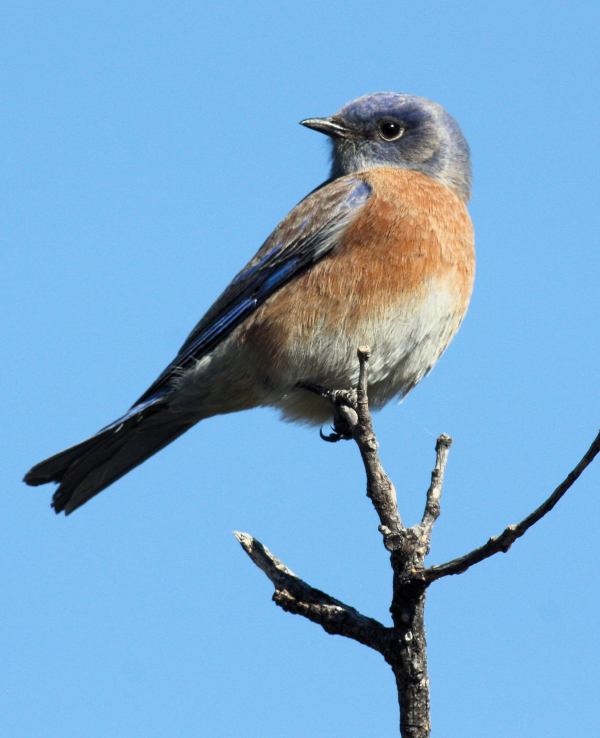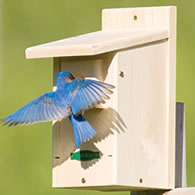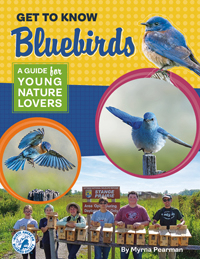
A male Western Bluebird on territory is a thrilling sight for many birders that provide a nest box, or many nest boxes for cavity nesting birds (photo by Paul Konrad).

An example of a well-built nest box is the Duncraft Bluebird House, which can be referenced at Duncraft.com: Duncraft WSB Eastern Bluebird House

The North American Bluebird Society’s free downloadable publication: Get to Know Bluebirds: A Guide for Young Nature Lovers. This excellent new book is aimed at a young audience, but the messages are applicable for everyone.
|
North America is blessed with the only bluebirds in the world; 3 species, appropriately named for their respective ranges – Western, Eastern, and Mountain Bluebirds. These small colorful birds provide characteristic spring songs for many birders across the continental United States and southern Canada. Bluebirds are considered the most popular cavity nesting birds, and the standard birdhouse is built to suit bluebirds, while other models are smaller for wrens and chickadees, or much larger for kestrels and screech owls.
Nonetheless, other cavity nesting birds benefit in big ways by utilizing nest boxes provided for bluebirds, and this is especially true along bluebird trails – a collection of birdhouses installed along a trail that can be walked or driven to maintain and monitor the activities of cavity nesting birds. Certainly, Tree Swallows have been primary beneficiaries of these lines of birdhouses, along with Violet-green Swallows in the West, a variety of wren and chickadee species, and many others.
Whether your interest is bluebirds, or cavity nesting species in particular – there are 88 species in North America that nest in cavities, and can benefit from the addition of each nest box added to the landscape. But there are some very important basic things to keep in mind to be a nest box provider and landlord. In short, it’s not enough just to install nest boxes. This point is best described in a list of things to keep in mind before and after installing a birdhouse, or a nest box trail, based on information provided by the North American Bluebird Society:
– It is essential that all birdhouses must be monitored at least once a week during the nesting season to address problems as they occur, including competitors (sparrows and starlings), predators, blowflies and their larvae, wasps or bees, and other disturbances.
– Whether you build a nest box or buy it, be sure the size and design of the nest box are appropriate for the birds you wish to attract. Use approved construction materials, provide the proper entrance hole size, position the entrance hole the right height from the floor; provide the right size of floor area, install drainage holes and air vents with sufficient roof overhang; absolutely provide predator proofing, etc.
– It’s also important to be able to open each nest box to allow for ease of routine monitoring and maintenance. A hinged side panel is best, although sometimes a hinged front is used by some manufacturers.
– Each nest box must be installed properly, secured at the appropriate elevation (not hung) using a metal, stand-alone pole that has a proper predator control added, such as a broad metal skirt, to keep mammals ranging from squirrels to raccoons from climbing the pole, as well as members of the family of “rat snakes” in the south.
– Nest boxes should be positioned so you can easily monitor and maintain them.
– Be sure to position bluebird nest boxes within preferred bluebird habitat – an open area with low grass interspersed with scattered trees. If you are trying to attract other cavity nesting species, position a nest box in appropriate habitat for those birds.
– Keep bluebird nest boxes a safe distance from brushy areas – wren habitat – unless you are trying to attract wrens.
– Also keep nest boxes away from locations where House Sparrows will be a problem – it’s hard to devote the time to keep sparrows from taking over your nest boxes meant for native birds.
– In some areas of the country, a pair of bluebirds may nest 2, or even 3 times during a single season. The monitoring birder should be ready to clean out the old nesting material in a given nest box after the nestlings have fledged, so the adult pair can start a new nesting cycle, which involves building a new nest – nest building is an important part of the recycling behavior and physiology of many nesting birds.
– In the case of a nest box trail, there should be a plan to continue the monitoring of the trail of nest boxes should the builder of the trail move or otherwise end their activities. Nest box trails can stand for many years, and if they are not being monitored each nesting season, they should be taken down or their entrances should be plugged. What? Yes, untended nest boxes fall into disrepair and become unsafe for nesting birds, and unmonitored nest boxes allow non-native species such as House Sparrows to flourish in an area, creating greater competition for nest sites with bluebirds and other native cavity-nesting birds.
To help you address many of these points, there are some excellent references to help you, including the North American Bluebird Society at North American Bluebird Society (nabluebirdsociety.org) along with the Cornell Lab of Ornithology’s NestWatch website at NestWatch | Features of a Good Birdhouse - NestWatch
The North American Bluebird Society also provides a very helpful and inspiring Free downloadable publication: Get to Know Bluebirds: A Guide for Young Nature Lovers. This new book is aimed at a youth audience, but the messages are applicable for everyone; see Get to Know Bluebirds_A Guide for Young Nature Lovers.pdf (nabluebirdsociety.org) There is a lot more information about other birds included in the book beyond the bluebird info we expected! And excellent photos to see.
Whether you have one birdhouse in your yard, or a dozen positioned along a nest box trail, it’s all applicable, birdhouse by birdhouse, year after year. Installing and monitoring nest boxes is a fulfilling activity embraced by many birders, but as you now know, there is more to it than just installing a birdhouse.
The benefits of providing nest boxes for native cavity nesting birds, including the 3 species of bluebirds, has expansively important conservation results, year after year, as pairs of birds search out safe nesting cavities to reproduce and bolster existing population numbers. We birders are an important force in the annual success of cavity nesting birds – and we congratulate and applaud everyone who takes part in that important endeavor! Enjoy the upcoming nesting season!
Share your backyard birding experiences and photos with The Birding Wire at editorstbw2@gmail.com